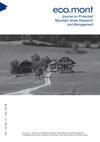Understanding Pacific Northwest (U.S.) mountain climbers’ motivations: Mount Baker, Washington, and Mount Hood, Oregon
IF 0.8
4区 环境科学与生态学
Q4 BIODIVERSITY CONSERVATION
Eco Mont-Journal on Protected Mountain Areas Research
Pub Date : 2020-01-01
DOI:10.1553/eco.mont-12-1s4
引用次数: 2
Abstract
Mountaineers are motivated to climb for myriad reasons, both intrinsic and extrinsic. This study examined the motivations of recreationists to climb on Mt. Hood, Oregon, and Mt. Baker, Washington, and how these motivations varied between mountain wilderness locations. Data were collected through onsite, mail and online surveys at two separate mountain settings (N = 865). The survey instrument included 22 motivation items designed to measure seven motivational domains. The results found that the primary motivations of all climbers focused on the aesthetic quality of mountain locations, physical fitness, escaping normal routines, and gaining a sense of accomplishment. An independent samples t-test revealed differences in the motivations of climbers at Mt. Hood versus Mt. Baker, while a Linear regression tested the role of motivation on participation. Most notably, climbers at Mt. Baker gave greater importance to recognition and catharsis as motivations. These findings showed that while recreationists climb for many of the same reasons, they are motivated to climb for different experiences offered by different alpine settings. The motivation regression model was a weak predictor of participation. This information on motivations could assist federal land management agencies in gaining a better understanding of how to balance climbers’ needs with preserving high-altitude environments. Research eco.mont – Volume 12, Number 1, January 2020 ISSN 2073-106X pr int vers ion – ISSN 2073-1558 onl ine vers ion: ht tp://epub.oeaw.ac.at/eco.mont ht tps://dx.doi.org/10.1553/eco.mont-12-1s4 4了解太平洋西北地区(美国)登山者的动机:华盛顿州的贝克山和俄勒冈州的胡德山
登山者登山的动机有无数的原因,既有内在的,也有外在的。这项研究调查了休闲主义者攀登俄勒冈州胡德山和华盛顿州贝克山的动机,以及这些动机在山区荒野地点之间的差异。在两个不同的山区通过现场、邮件和在线调查收集数据(N = 865)。调查工具包括22个动机项目,旨在测量7个动机领域。结果发现,所有登山者的主要动机集中在山区的审美质量、身体健康、逃离常规和获得成就感。独立样本t检验揭示了胡德山和贝克山登山者动机的差异,而线性回归测试了动机对参与的作用。最值得注意的是,贝克山的登山者更重视认可和宣泄作为动机。这些发现表明,尽管休闲主义者出于许多相同的原因攀登,但他们是为了获得不同高山环境提供的不同体验而攀登的。动机回归模型是参与的弱预测因子。这些关于登山动机的信息可以帮助联邦土地管理机构更好地了解如何平衡登山者的需求和保护高海拔环境。研究生态。月- 12卷第1期2020年1月ISSN 2073-106X pr int vers ion - ISSN 2073-1558 online vers ion: http://www.epub.oeaw.ac.at/eco。月tps://dx.doi.org/10.1553/eco.mont-12-1s4
本文章由计算机程序翻译,如有差异,请以英文原文为准。
求助全文
约1分钟内获得全文
求助全文
来源期刊

Eco Mont-Journal on Protected Mountain Areas Research
BIODIVERSITY CONSERVATION-ECOLOGY
CiteScore
1.20
自引率
0.00%
发文量
1
审稿时长
>12 weeks
期刊介绍:
eco.mont offers a platform specifically for scientists and practitioners working in and on protected mountain areas in Europe and overseas.Target audiences of the journal are scientists from all related disciplines, managers of protected areas and an interested public including practitioners, visitors, teachers, etc.
 求助内容:
求助内容: 应助结果提醒方式:
应助结果提醒方式:


